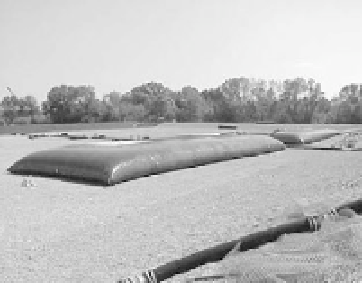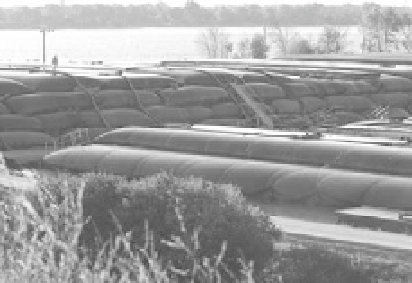Environmental Engineering Reference
In-Depth Information
Dredging is most appropriate for exposed and accessible “hot spots” that pose significant risks. Dredging
is very attractive conceptually to the public because the contamination removed and stored in a designed
containment facility. However, there are many important problems with dredging.
First, dredging will leave a significant residue of contamination behind in the biologically available
zone (approximately top 10 cm) that will require capping after completion of dredging activities or, absent
such a post-dredging cap, will require repetitive dredging that may protract the recovery of the river by
decades. Thus, dredging is far less certain than capping to achieve any given remedial design standard
and will leave residual contamination in the biologically available zone (Lue-Hing et al., 2001).
Second, because of the disturbance to the bottom, dredging activities may be expected to result in
higher contaminant concentrations in the water column and contact with exposed underlying contaminated
sediments during and after cleanup completion until natural recovery processes isolate the residual
contamination (Lue-Hing et al., 2001). That is, dredging will generally result in the interim exposure of
sediments with higher contaminant concentrations that are not in equilibrium with the water column. Thus,
significant contaminant releases into the water column can result during dredging operations.
Third, siting and permitting requirements of the requisite landfill/CDF may impose significant restrictions
on the rate and productivity at which a river dredging project can proceed without further degrading the
river's water quality. Some projects, such as the Kinnickinnic River Great Lakes Legacy Act Cleanup in
Milwaukee may have access to an already designated CDF, however, for many others new CDFs must be
developed and permitted before dredging can begin.
Fourth, wastewater and spoil management challenges associated with dredging are difficult to solve
for large-scale projects. For example, Lue-Hing et al. (2001) reported that for the Fox River, Wis., U.S.
treatment and disposal of the PCB contaminated sediments and the sediment-loaded wastewater will
require development of a substantial infrastructure not currently in existence. For the Fox River the spoil
management problem was solved by pumping the hydraulically dredged sediment water mixture into
geotextile tubes (Fig. 9.25). The geotextile tube allows the water to flow out in response to hydrostatic
pressure, which often is increased by stacking geotextile tubes (Fig. 9.25), while the vast majority of
sediment is retained in the tubes. The water that “seeps” through the geotextile tubes is collected in a
gravel-lined dewatering pad and is pumped to water treatment facilities. Once dewatered and dried in the
geotextile tubes, the sediment may be removed and taken to the landfill/CDF.
Fig. 9.25
Geotextile tubes being filled by dredged sediment and water (left) and stack of geotextile tubes dewatering
(right) at the Little Lake Butte des Morts project of the Fox River, Wisconsin, U.S. (photos provided by Steven Laszewski)
(See color figure at the end of this topic)
Fifth, treatment of dredge wastewater is very complex. Typical wastewater constituents requiring
control include BOD, total suspended solids, PCBs, arsenic, cadmium, chromium, copper, lead, mercury,
DDT and its metabolites, pentachlorophenol, dieldrin, and endrin. The simultaneous presence of PCBs,



Search WWH ::

Custom Search